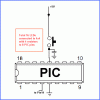My wife needed from me an idea for designing a simple Assistive Equipment to be used by disabled children for one of her Speech and Language Therapy courses and I thought on designing a small square box with a 4x4 array of LED's (16 LED's) connected to a push button that while it is being pressed the LED's shall be turning on one at a time in order from left to right and then going to the next row and so on until that sequence will start again.
It seems to be a simple pattern and I wish to get some ideas on how to build this device. I just want to know if there is an IC available that I can use for this purpose or if I will be needing several logical gates (AND's, OR's, etc) for the design.
I'm an electrical engineer, but I'm afraid (and a bit embarrassed) that I forgot most of the theory learned at College at this point (it has been about 13 years since that moment... lol!) and I know that at that moment that would be a simple design that I could make myself in 5 minutes probably but at this point I'm out of ideas.
Please anyone let me know if I can get any ideas on this.
Thanks,
It seems to be a simple pattern and I wish to get some ideas on how to build this device. I just want to know if there is an IC available that I can use for this purpose or if I will be needing several logical gates (AND's, OR's, etc) for the design.
I'm an electrical engineer, but I'm afraid (and a bit embarrassed) that I forgot most of the theory learned at College at this point (it has been about 13 years since that moment... lol!) and I know that at that moment that would be a simple design that I could make myself in 5 minutes probably but at this point I'm out of ideas.
Please anyone let me know if I can get any ideas on this.
Thanks,




